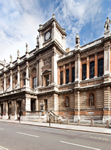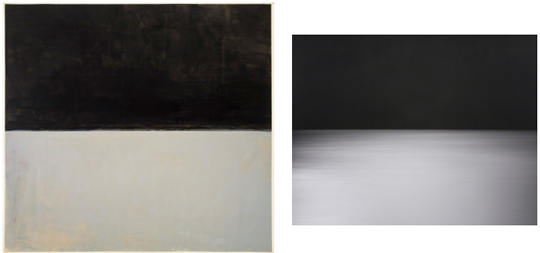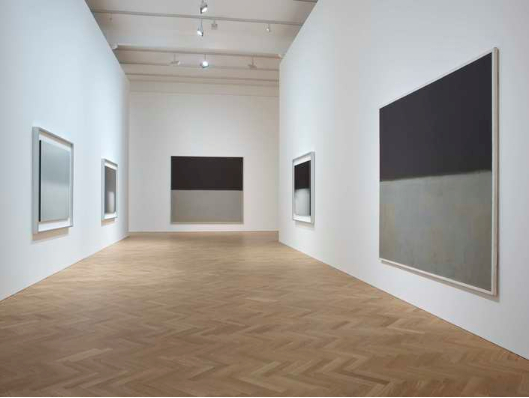|
Rothko/Sugimoto: Dark Paintings and Seascapes Pace
gallery 4 October – 17 November 2012 Monday through Saturday, 10 a.m. to 6 p.m. |
 |
Following its recent announcement of plans to open a major gallery in Mayfair, Pace London is honored to present Rothko/Sugimoto: Dark Paintings and Seascapes at 6 Burlington Gardens from 4 October through 17 November 2012. The inaugural exhibition (renovated by architect Sir David Chipperfield, 6 Burlington Gardens features 9,000 square feet of exhibition space and abundant natural light) juxtaposes Mark Rothko's late black and grey paintings with Hiroshi Sugimoto’s contemporary photographs of bodies of water. The exhibition marks the first private gallery presentation of Rothko’s work in London in nearly fifty years and continues Pace’s five-decade tradition of exhibitions that explore affinities between artists working across decades and mediums.
 |
|
|
Mark Rothko, Untitled, 1969. Acrylic on canvas,
105 x 113-3/4". © 1998 Kate Rothko Prizel and Christopher Rothko / Artist
Rights Society, New York (ARS).
|
Hiroshi Sugimoto, Bay of Sagami, Atami, 1997. Gelatin
silver print, 47 x 58-3.4". c Hiroshi Sugimoto
|
Dark Paintings and Seascapes pairs eight acrylic paintings by Rothko and eight gelatin silver prints by Sugimoto, revealing two different artistic approaches that arrive at similar conclusions. Rothko's use of medium as pure abstraction communes with the work of Hiroshi Sugimoto who, decades later, used the medium itself to reconsider photography's relationship to his viewers’ perception of the world. In addition to exploring the visual dialogue between Rothko’s dark paintings and Sugimoto’s photographs—both characterized by a binary format of black and grey rectangular elements—the pairings mine the philosophical affinities between the two artists, each offering a meditation on universal and cosmological concerns.
The exhibition will be accompanied by a catalogue by Richard Shiff, the Effie Marie Cain Regents Chair in Art and director of the Center for the Study of Modernism at the University of Texas at Austin. “Rothko and Sugimoto think in terms of eras of history and eons of organic life, not the decades of their own lives,” Shiff writes. “Rothko had directed his art, as Sugimoto does now, to a primal, evolutionary sense of being human. What is true of Rothko and Sugimoto becomes true of all of us when we attend to their experience—if we encounter the limits of human feeling and perception that Rothko’s paintings and Sugimoto’s photographs represent. We then recognize the condition that already constitutes our living … Immersed in an artist’s sea of light—this aesthetic entry into nature, history, and other beings—we become aware of our conscious awareness.”
 |
|
|
© 2012 The Pace Gallery, All Rights
Reserved
|
The concept for the exhibition originated in 2010, when Hiroshi Sugimoto joined Pace and was introduced to Christopher Rothko, the son of Mark Rothko. Pace has worked with the Rothko family since 1978 and has presented ten exhibitions devoted to the history of the artist’s work.
In preparation for the exhibition, Sugimoto reflected, “For several decades I have created seascapes. Not depicting the world in photographs, I’d like to think, but rather projecting my internal seascapes onto the canvas of the world. Skies now forming bright rectangles, water now melting into dark fluid rectangles. I sometimes think I see a dark horizon cutting across Mark Rothko’s paintings. It’s then I unconsciously realize that paintings are more truthful than photographs and photographs are more illusory than paintings.”
Painted a year before his death, Rothko’s dark paintings of 1969 represented the first radical break from his signature form in over two decades. He abandoned both the orchestral range and shimmering banks of colour that had defined his earlier work, reducing each painting to two distinct rectangles, one dark and one lighter. Though Rothko had engaged with darkness before—notably in the Seagram paintings of 1958–59 and the commission for the Chapel at the Menil Collection in Houston from 1964–67—in the late work he limited his palette to black and grey, with traces of dark brown, maroon, and blue visible. The paintings are surrounded by a white margin, unique to this series, that isolates the field and emphasizes its flatness.
Though sombre and even elegiac in colour and mood, the dark works relate less to any personal tragedy in Rothko’s life, and more to eternal and depersonalized metaphysical questions. As the critic Brian O’Doherty wrote in his 1985 catalogue essay for Pace’s exhibition of Rothko’s late paintings, “The works contracted to windows of some original darkness.”
Sugimoto’s Seascapes (begun in 1980) depict bodies of water from the English Channel to the Bay of Sagami, each photographed in the same stark composition of a horizon line dividing the sky and sea. Divided into two rectangles—one dark, one light—the relationship between sea and sky takes on an almost abstract geometry that carries from image to image and ocean to ocean around the world. Like Rothko, Sugimoto conveys a startling range of emotions within a limited vocabulary of black and white tones and a fixed format. Focusing on water and air—the substances that gave rise to life—the works evoke primordial seas and the origins of human consciousness.
Rothko/Sugimoto extends Pace’s ongoing series of two-artist exhibitions that initiate dialogues between artists working across time periods, geography, and mediums, following such significant exhibitions as de Kooning/Dubuffet: The Women (1990); Mondrian/Reinhardt: Influence and Affinity (1997); Bonnard/Rothko: Color and Light (1997); Willem de Kooning and John Chamberlain: Influence and Transformation (2001); Dubuffet and Basquiat: Personal Histories (2006); Josef Albers/Donald Judd: Color and Form (2007); and Ad Reinhardt and Tony Smith: A Dialogue (2008–9).
Mark Rothko (1903–1970) was born in Dvinsk, Russia and immigrated to the United States in 1913. Widely considered one of the most important artists of the twentieth century, he studied painting at Yale University from 1921–23, and in 1969 was awarded an Honorary Doctorate of Fine Arts from the school.
Hiroshi Sugimoto (born 1948, Tokyo) has lived and worked in New York City
since 1974. Preserving and picturing memory and time is a central theme of
Sugimoto’s photography
Pace is a leading contemporary art gallery representing many of the most significant
international artists and estates of the 20th and 21st centuries. Founded
by Arne Glimcher in Boston in 1960 and led by Marc Glimcher, Pace has been
a constant, vital force in the art world and has introduced many renowned
artists’ work to the public for the first time. Pace has published nearly
350 exhibition catalogues and mounted more than 700 exhibitions, including
scholarly exhibitions that have subsequently travelled to museums. Today Pace
has seven locations worldwide: four in New York; two in London (Pace London’s
second space is located at 6-10 Lexington Street in Soho) and a gallery in
Beijing.
In the summer of 2012, Pace London announced plans for its flagship gallery
at 6 Burlington Gardens, located directly north of the Royal Academy’s
Burlington House.
